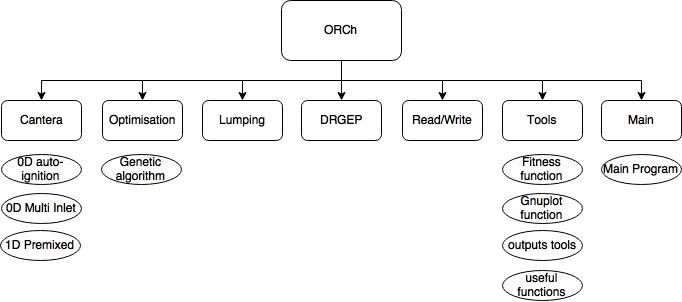Main Page
From orch
ORCh background
ORCh (Optimised and Reduced Chemistry) is a fully automated method to reduce detailed chemical schemes. This page describes the architecture of the method and explains how to install and run ORCh.
The development of ORCh is reported in two archival papers (make sure to cite those papers when using this program):
- N. Jaouen, L. Vervisch, P. Domingo, G. Ribert (2017) Automatic reduction and optimisation of chemistry for turbulent combustion modeling: Impact of the canonical problem, Combust. Flame, 175: 60-79.
- N. Jaouen, L. Vervisch, P. Domingo (2017) Auto-thermal reforming (ATR) of natural gas: An automated derivation of optimised reduced chemical schemes, Proc. Combust. Inst., 36(3): 3321-3330.
ORCh has been applied to various reactive flow problems:
- K. Bioche, G. Ribert, L. Vervisch (2019) Simulating upstream flame propagation in a narrow channel after wall preheating: Flame analysis and chemistry reduction strategy, Combust. Flame. 200: 219-231.
- C. Locci, L. Vervisch, B. Farcy, P. Domingo, N. Perret (2018) Selective Non-Catalytic Reduction (SNCR) of nitrogen oxide emissions: A perspective from numerical modeling, Flow Turbulence and Combust. 100(2): 301-340.
- K. Bioche, L. Vervisch, G. Ribert (2018) Premixed flame-wall interaction in a narrow channel: Impact of wall thermal conductivity and heat losses, J. Fluid Mech. 856: 5-35
- A. Bouaniche, N. Jaouen, P. Domingo, L. Vervisch (in press) Vitiated high Karlovitz n-decane/air turbulent flames: Scaling laws and micro-mixing modeling analysis, Flow Turbulence and Combust
ORCh is a preprocessing tool designed to automatically generate and optimise reduced chemistry for specific CFD conditions, including fuel spray, heat losses, etc.
ORCh combines stochastic methods with graph-analysis together with genetic algorithms
Written in C++ it comes with a user friendly interface
Most recent and on-going applications
- Furnaces with Urea DeNOx
- High-pressure partial oxydation of methane (hydrogen production)
- Combustion in narrow channels with wall heat losses (micro- and meso-scale combustion, fire propagation between battery cells)
- Heavy hydrocarbon liquid fuel (kerosene surrogate or pyrolyse)
- Chlorofluorocarbon chemistry
- Soot precursors
- Coal combustion
- Combustion of blast furnace gases
Architecture of the method
Tools

